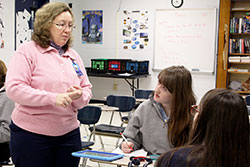Catholic Schools Week Supplement
Teacher strives to launch interest of students in science

As a teacher at Our Lady of Providence Jr./Sr. High School in Clarksville, Laura Swessel uses her engineering background and connections to make science come alive for her students. (Submitted photo)
By Christa Hoyland (Special to The Criterion)
CLARKSVILLE — Laura Swessel has worked with top engineers around the world and as a mission controller for satellite launches. She also has a patent on a fuel gauge for a satellite.
With those accomplishments, a bachelor’s degree in aerospace engineering from the Massachusetts Institute of Technology (MIT) and a master’s degree in mechanical engineering from the New Jersey Institute of Technology, she could work at a top engineering firm.
But Swessel chooses to teach junior high science and high school Earth/space science and physics at Our Lady of Providence Jr./Sr. High School in Clarksville.
She came to the school in the fall of 2012 as a part-time honors physics teacher while also teaching as an adjunct professor at Indiana University Southeast in New Albany. When the opportunity to teach full-time at Providence arose in 2013, Swessel gladly accepted.
Swessel began her career as an aeronautics engineer with Lockheed Martin in Princeton, N.J. When the plant closed eight years into her career, she and her fiancé, John, chose to marry and move to the Louisville, Ky., area, where he grew up. They moved a few miles north of the city to Georgetown, Ind., and she started her own consulting business and began teaching at IU Southeast, allowing her to pursue “the best of both worlds,” she said.
She quickly embraced life as a high school teacher and said the Catholic school environment had a closeness between the students and faculty that was lacking in her own public high school in her home state of Maryland. She fosters that closeness in her classroom by holding lunch meetings with her students at the beginning of each semester.
“I get more interaction in the classroom,” she said. “It’s a positive for them, and a positive for me. It’s definitely worked out both ways.”
While Swessel enjoys the opportunity to get to know her students better, her primary goal is to help them enjoy science—and ultimately explore a career in science or technology. Her efforts to that end extend beyond her classroom.
Last semester, she brought in a guest speaker from the National Weather Service. She also set up virtual sessions with an ocean drilling vessel. And she took her students on a field trip to the Living Lands & Water barge. Each session supplemented a classroom lesson or demonstrated a type of science career.
“I just like to introduce new concepts to kids to get them interested in a career in science and technology,” Swessel said. “If they are already interested, I like to mentor or guide them.”
A number of the guest speakers or virtual opportunities were a result of her participation in the Duke Energy Academy, a weeklong summer program at Purdue University in West Lafayette, Ind. During the program, she wrote and shared lesson plans with fellow science teachers and attended sessions that gave her ideas for labs and lessons for her students.
One of those sessions resulted in Providence receiving the temporary use of a vertical wind shaft from WindStream Technologies. Swessel said she was intrigued by the wind shaft’s compact, lightweight design and how it is paired with solar panels to create a solar mill. She invited its inventor, Dan Bates, CEO of WindStream Technologies, to lead a before-school session for students. That session then led to future labs in which students created a mini-wind farm from repurposed materials.
Swessel also entered in several lotteries while at the academy and won the chance for students to witness a core extraction off the coast of Japan via a live video event with the crew of the JOIDES Resolution Ocean Drilling Vessel. Students received a virtual tour of the vessel and learned what the researchers were studying from the Earth’s core.
Because of her degree from MIT, Swessel also made it possible for students to attend a virtual symposium as the university celebrated the 100th anniversary of its Department of Aeronautics and Astronautics. Students were able to view a question-and-answer session with shuttle astronauts and a tour of MIT laboratories.
Swessel said she is always looking for ways to enhance her lessons to show her students how their subject matter can be used in their lives or a future career.
Maresa Kelly, a junior in Swessel’s Honors Physics class, said she appreciates the speakers and opportunities her teacher has brought to the school this year.
“It’s different than when you’re in class, and all you do is math,” Maresa said. “It was neat to see all the applications of physics in the real world.” †
